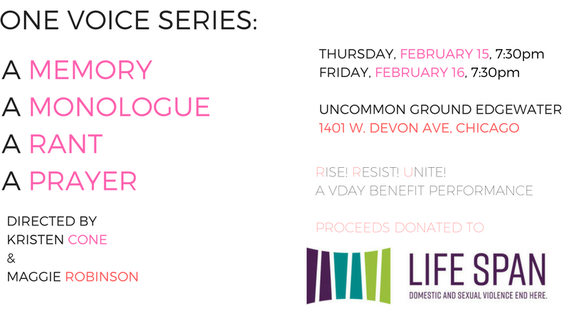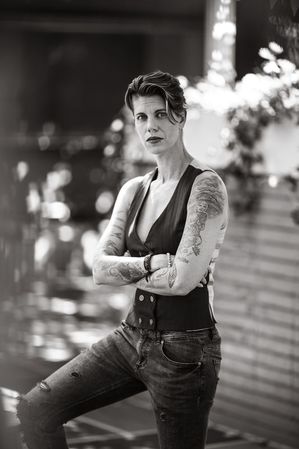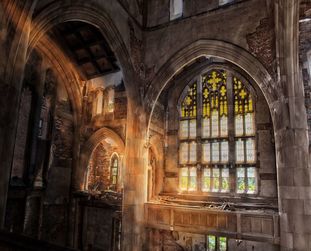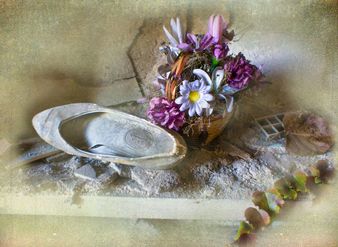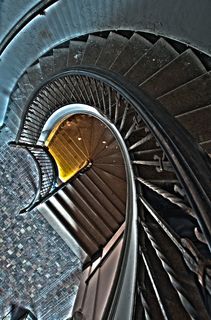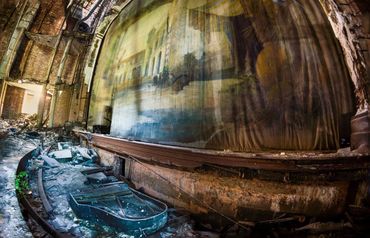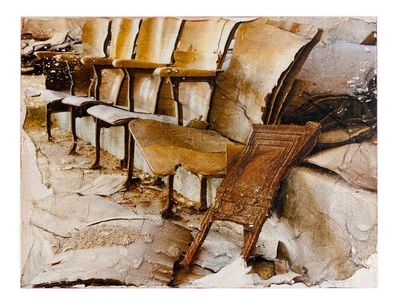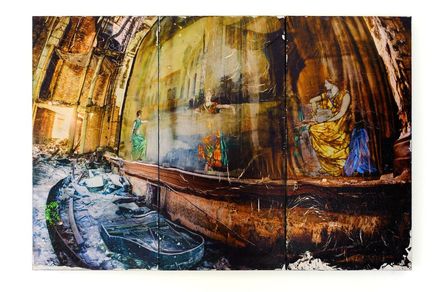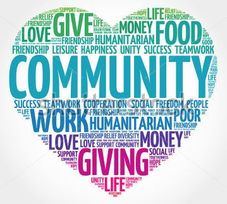 What is community? Is it the people you’re around? Is it the feeling you get when you’re around a certain group of people? Is is active or passive? Is there a definition or is it as abstract as anything else that is specific to each individual? What happens when you find yourself outside of a community and in turn, how do you make your way in? Whenever I think of community outreach, these are the questions I have to ask myself. Yes, marketing and outreach are strategic but there’s also just this aspect of just being a human being trying to connect with someone else. It’s this sense of inviting someone in and in return, hoping to be let in as well. When I think of community and outreach, I go into it with a sense of just trying to get to know someone. I don’t particularly want anything from you other than to meet you, get to know you better. No one is oblivious. They can tell when you just want something from them or when you’re oozing with fakeness. No one wants to be networked. People do want to feel special and listened to. They do want relationships that gives just as much as it takes. In doing community outreach, I want to challenge people to get to know one another. Not because we want something from one another. Not to network but simply just to be together. You’d be surprised how quickly you can befriend a stranger, the things you confide in them or feel safe around them. We live in a world where we are so scared of people, things or beliefs that are different than us. We meet it with rage, hostility and hatred yet we fail to realize that we are all more similar than we are different. We don’t actually fear that thing that we tell ourselves is scary or dangerous. What we actually fear is that we may like that person we’re told is a threat. We might resonate with an idea we were brainwashed to think is radical. We might actually be good at an activity we were told would emasculate us. But we must push past those fears. We must reach out. Reach out to converse with a stranger. Reach out of our comfort zone. Reach out to include or accept. Reach out for help or understanding. We just need to reach out. For ourselves. For each other. For that is building community. That’s why we use the term “building a community” not “maintaining a community”. The work is never done. So smile at a stranger. Ask someone to inform you about something you don’t know. Go to a different restaurant. Try a new activity. Realize that expanding your community broadens your perspective and helps you grow into a person you never thought you’d expect to be. Realize that you may find yourself with an ever-growing community of people that may all come together because of you. So I hope you come out and see a show at Chicago Danztheatre or support our fundraisers. We work for and collaborate with people from all walks of life. We tell stories that people never thought they’d resonate with. We intermingle communities of all kinds from the CPS community, to the prison community, to the artist community and beyond. We truly believe that it is possible for us all to learn from one another. It’s possible to simply exist with one another, to listen, to be heard and to share. You are always welcome in the CDE community because it is a safe place. We are one community. And as always, like our Chicago Danztheatre Ensemble Facebook page or follow us on Instagram @danztheatre.
24 Comments
The following blog post may be triggering for some readers. The survivor story comes an Ensemble member of MMRP. Though she wanted to share her story, she asked to keep her identity anonymous. Throughout our rehearsal process, this line in the Blueberry Hill monologue by Christine House has always stuck in my mind. Though I always take it out of context, I go back to January 27, 2015, to the words coming out of my own mouth as I ran out of a dorm to my friend’s car – “it wasn’t consensual but it wasn’t rape." Over and over again, I spoke those words during the ride back to my apartment, while talking to my roommate, while crying to my ex over the phone, while telling my friend, while talking to the doctor, while talking to the investigative team at the hospital. It was supposed to be studying at a classmate’s apartment. It turned into a hook up and then into a non-consensual sexual encounter. At first, I just told him it hurt. He stopped after a couple minutes and persuaded me to try again. I told him it hurt again and tried to push him off, crying as he asked me if it felt good and I said "no." When I finally got him off of me, I grabbed my clothes and kept putting them on as he asked for me to continue and for us to finish together. I told him he had two hands and he could use them. As I ran out the door, I called friends to try to get a ride back home since I was on the university's other campus and felt too disorientated to figure out how to get back to my apartment. That night changed me. While I was able to seek justice through the university, it was not easy. My grades plummeted from straight A's to B's, C's and even a D. The doctors at the hospital found multiple tears in my vagina and advised that even with a condom used, that I should go on HIV antivirals since his status was not known and Richmond was having a problem with HIV at the time. The medications caused terrible nausea, and caused me to throw up. I had to repeat my story over and over again as the classmate kept appealing the case and other victims came forward with similar situations. I kept questioning if it was really rape since it had started consensually. After all – “you can’t rape the willing”. I had to come to terms with what had happened to me. It was not as traumatic as other rapes I heard about. But it was detrimental to my progress and even as I fought back through the university, it took a year. Near this time in 2016, I had the final word from the university that he was expelled. After countless interviews with university officials, it was done. I participated in MMRP so I can keep healing and moving past what happened to me. By hearing others stories and being able to use dance to express them, I’m realizing that I’m not a victim. I’m continuously surviving. And others are learning how to survive as well – I’m not alone in this journey. We can bring awareness and hope even as we’re fighting an overwhelming darkness. Click here for tickets One Voice Series is a part of Chicago Theatre Week! Use the code, “CTW18” for a $15 general admission ticket. Call Uncommon Ground Edgewater to book a table. 773.465.9801 Moments like this Stillness... The crackling sound of my heater A forced exhale from a hard days work Moments where A tightness occurs in your body previous stories wrapped in words Edgy perceptions Does anyone ever Really know who we are What we have been through? What's your process How do you get through? When life alters your reality How do you learn to trust to forgive... I watch people carry baggage Adding something new every corner they turn That suitcase Beat up on the edges Still can carry things To and from just about any location That suitcase contains The past The present And the future It's not visible Some of us Hide it Better than others Some of us Look like We are not wrapped in Despair Or Carry the karmic imprint of life long lessons Some of us are just here looking for community looking to fit in to be accepted And Art And Pain Often Pair together I realize We are not alone in any of our thoughts Someone Somewhere Is thinking this very same thing Artistry Changes Life Enables Light to Peer through Even the darkest tunnel Stories Break us down Remove our ego Force us to feel and feeling Is not something our society has a great deal of experience with... Reacting vs responding Defending vs understanding This is what we know What we were trained to do What would it look like to flip the script To respond vs react To understand vs defend "It is like that moment when the rollar coaster starts and you know there is no turning back. Whatever is to happen is out of your control, you have no choice, but to proceed!" ~Christine House, Blueberry Hill~ Excerpt from A Memory A Monologue A Rant A Prayer Edited by Eve Ensler (author of Vagina Monologues) and Mollie Doyle Kristen Cone is one of the co-directors of this year's One Voice Series. She is an independent interdisciplinary artist, producer and full-time drama teacher. She also plays the Australian didgeridoo with the Chicago Didjuridu Chorus to honor the season Solstices and Equinoxs. See this year's One Voice Series: A Memory, A Monologue, A Rant, A Prayer on February 15 and 16, 7:30pm at Uncommon Ground Edgewater (1401 W. Devon Ave). Proceeds will be donated to Life Span, an organization committed to ending violence and keeping women safe. Use the code, "CTW18" for a Chicago Theatre Week ticket! Click for tickets. CHICAGO DANZTHEATRE ENSEMBLE IS AWARDED THE MACARTHUR GRANT FOR INTERNATIONAL COLLABORATIONS11/7/2017 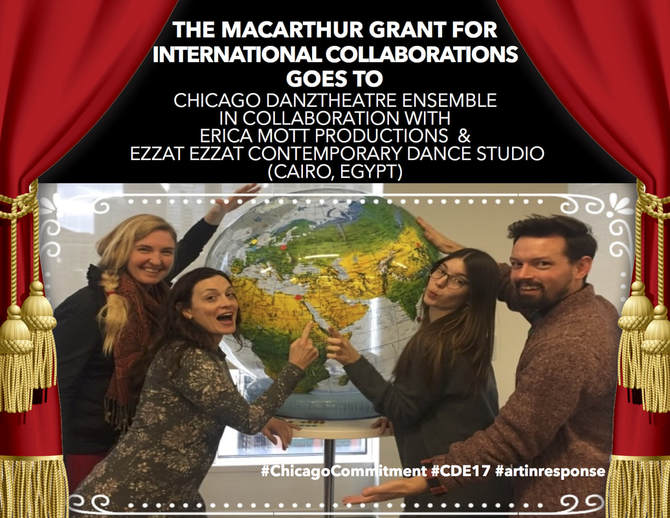 CHICAGO, November 6, 2017 Chicago Danztheatre Ensemble is thrilled to announce that we have been award a $50,000 grant for an international collaboration between Erica Mott Production and Ezzat Ezzat Contemporary Dance Company. We are thankful to be one of nine Chicago area arts organizations to be granted this award by the MacArthur Foundation. The John D. and Catherine T. MacArthur Foundation today awarded grants to nine Chicago arts and culture organizations for diverse artistic exchanges in eight countries, including Mexico, South Africa, Sri Lanka, and the United Kingdom. “Cross-cultural exchanges bring renewed perspective and vision to Chicago’s vibrant arts and culture organizations,” Chicago Commitment Director Tara Magner said. “International collaborations also help music, dance, art, and theater audiences understand other cultures better, offer a meaningful experience in a troubled world, and allow people to feel more connected to each other and their city.” This collaboration started between Erica Mott Productions and Ezzat Ezzat Contemporary Dance Company with a residency exchange this past year that ended with a showing at High Concepts Laboratory. The Mycelial Cycle is an interactive multimedia installation performance that investigates civic participation and social movements in the digital age, inspired by activists' use of social media during the 2011 occupation of Tahrir Square. Developed through a series of one-to-one cultural exchanges between American and Egyptian composers, computer programmers, dancers and new media artists, and augmented through local community workshops, The Mycelial Cycle will provide pathways to kinesthetic empathy and a platform for dialogue and deeper connection between local communities in Cairo and Chicago. Mycelial - from the word "mycelium" - refers to the branching hyphae of a fungus, which form extensive communication networks that nourish entire forest root systems. This metaphor aptly reflects the ethos of The Mycelial Cycle: creating a nourishing, multi-faceted network through the collaborative cultural production of three distinct companies of performance and media artists and their constituents. The artists aim to utilize the performers' bodies in real time to better understand collective living in a culture of instantaneity. By employing digital technology, dance and music, Mycelial will shine a light on different experiences of time as it relates to the body in action. This will serve as a catalyst towards dialogue, knowledge exchange and potential future relationship building between Egyptian and American dancers, musicians and coders. Chicago Danztheatre Ensemble (CDE) has a history of engaging diverse Chicago communities through educational programs, workshops and performances that use the arts to encourage English literacy and cultural understanding. In light of recent political isolationism, the refugee crisis and proposed Muslim travel ban, CDE has become particularly interested in bridging local Chicago communities to the Arab world to reinforce Chicago's commitment to being a sanctuary city. The partnership with Erica Mott Productions (EMP) and collective exchange with Cairo-based Ezzat Ezzat Contemporary Dance Studio (EECDS) support the cross-pollination of new ideas and the sharing of vital resources between Chicago dance and theatre makers. Between January 2018 and April 2018, CDE, EMP and EECDS will host a series of online video exchanges between Chicago and Cairo. These exchanges will develop creative content that respond to each other's choreography, a custom mobile device app and a live video feed that will be used in the final performance in July 2018. CDE will then look at how the 2011 occupation of Tahrir Square - the original inspiration behind the collaboration between EMP and EECDS - has inspired subsequent social movements like Occupy Wall Street and the Women's March using the same technologies. The The Mycelial Cycle is apart of Chicago Danztheatre Ensemble's 17th season and will continue into their 18th season both themed "Art in Response.” Chicago Danztheatre Ensemble (CDE) celebrates their 17th performance season, entitled, Art in Response. Art in Response focuses on the collection of voices of CDE and their response to the world. Chicago Danztheatre Ensemble's 17th performance season features new work, remounts and adaptations. CDE is one of the only multidisciplinary, arts organization creating works that elevate one voice, one story and one person at a time. Audiences should expect to feel challenged while watching a CDE performance leave feeling inspired. This 17th season promises to be honest and vulnerable, what CDE does best. #chicagocommitment #macarthur Ellyzabeth shared a video with the cast a few weeks ago - a silent film comprised of myriad images and scenes inspired by the story of Ethereal Abandonment. In one particularly special shot, we see feet clad in heels descending a set of stairs. The foot steps are slow and deliberate and a tad unsteady. We see the ankle and foot muscles and bones at work, keeping the actress balanced as she makes her move. At rehearsal that day, Nelia (the actress to whom those feet belong) made a comment about how wobbly her steps were. To that Ellyzabeth replied, "Wobbly is OK."
That got me thinking of how important vulnerability is in theatre and performance. Actors and dancers in rehearsal and on stage are called on to take risks. Through opening ourselves up to the work we knowingly expose ourselves to failure, judgment and embarrassment (to only name a few). But this is when the magic happens. Those nerve-wracking tasks of being open and taking risks are what enable us to create moments in performance that are truthful and unique. So this week as we begin tech rehearsals, I pose a challenge to myself and the cast to work with a sense of vulnerability. As the technical elements begin to build a strong skeleton for the show, let us continue to strengthen the malleable muscle, the beating heart of Ethereal Abandonment, remembering that vulnerability is powerful and yeah, wobbly is OK. Ethereal Abandonment: Timeless, or covering all times? We’re playing with the echoes of the characters that lived in this physical church, this imagined theater, this creative space, and hinting at several different generations of humans who have traipsed through each of these tangential time-space continuums. The Muses’ movements ripple across all time periods, weaving together the audience’s experience of multiple worlds being present at once on our stage.
It’s been an exciting challenge in understanding the difference between the various kinds of story telling that each medium in Ethereal Abandonment provides. We have a narrative story line, brief episodic snapshots, period dances from very distinct eras and styles, and non-linear, timeless movement that create a dream-like, multi-disciplinary experience for the audience that keeps surprising me. Our soundscape is the same in that it covers multiple styles and eras. “A Little Pink Rose” is a parlor song by Carrie Jacobs-Bond from 1912. Jacobs-Bond’s music was repeatedly turned down by music publishers due to the male-dominated industry until she established her own sheet music publishing company. She therefore owned every word of every song she wrote — not something many music artists can claim for themselves! Her independence as a woman is something I draw from in my character’s flight from her hometown to the big city…she realizes that she doesn’t want to have a traditional life at home with a husband and family, and shapes herself instead into a Vaudeville performer. The lyrics for “A Little Pink Rose” are nostalgic, asking if the pink rose has faded and gone away…when we grow, how much of our old selves remain, and how much has to be plucked away? How much of the original girl from a small hometown remains under the performer’s exterior? The ghostly echoes of times past and present linger in our space, in our characters, in our movement, and in our music. We’re informed and inspired by the past to actively shape and cultivate our present and future…in Ethereal Abandonment, we can see remembering and action taking place at the same time, pulsating in our voices and bodies with a vibrance that remains in the space long after we’re gone. Landmarks: What history is worth preserving?
Day jobs for artists are known to be soul-sucking voids to make ends meet. I am fortunate/lucky to have a day job that incorporates visual art, performing, and great office views. I'm an architecture guide on the Chicago River! Chicago has a rich history of architecture that has made impacts all around the world, including what is widely accepted as the world’s first skyscraper. While The Home Insurance Building was demolished long ago, Chicago still maintains and preserves many of its architectural treasures through the Commission on Chicago Landmarks. Landmark status allows for legal protections to honor and preserve the site’s history (i.e. prohibits demolition, required upkeep by owner, restrictions on redevelopment etc.) The process, though, to receive such status is not easy. The site or building must provide a significant historic, cultural, or artistic value to the community brought before and decided by the commission. With limited resources and a people being drawn back into cities not everything can remain the same, so the question remains: What is worth preserving? This question has been in the forefront of my mind as we created Ethereal Abandonment, in rehearsals and well as during my tours. We cannot learn from history if we do not remind ourselves of its residual effects of our daily lives. Yet if we cherish everything, then nothing is sacred. As audiences witness the stories told in our show, I hope they will also consider: With beautiful palaces of art like The Uptown Theatre (and the one created in our show) laying vacant and decrepit along the streets of Chicago, should they make way for the needs of today or be saved and forever etched into our city’s consciousness? And if the answer is the latter, which few places should we designate as indispensable? Are you a fan of Chicago's Corn Cob Towers? Well rejoice as they were welcomed into the collection of Chicago Landmarks this past winter! This performance would be entirely different if we had rehearsed in a theatre. Working in a church provides an authenticity to the process that we don’t have to manufacture. In Chicago especially, most theatre folk have performed in myriad locations, from an adaptable black box, to someone’s basement, to a bar, and of course, a church.
Religious background aside, I’ve always loved churches with their big open ceilings and (sometimes) stained glass. I see articles pop up about the fluctuation of church attendance and I wonder often what will happen to these beautiful buildings. You will see how Ethereal Abandonment addresses this issue, and while we rehearse the dances and brainstorm for script it’s easy to take this beautiful space for granted. But when I really think about it I’m so happy that this is where we perform. Various artistic and community groups utilize this particular church, for which I’m so glad! More and more, artists are taking advantage of the many churches in this city. Aloft Circus Arts, where I take classes, recently purchased a church for their classes and performances, and back home in Maine, a friend of my father's is working on converting a church into music venue. Not only do we get to create our own show in this space but the setting is ready made for us. We mold our performance to the atmosphere, we don’t have to bend it to fit to what we need. I’m so excited for share this show and perform in such a beautiful space. It’s easy to imagine I’m walking through an old theatre, and I so hope you’ll come one night, and find inspiration in the space, or at the very least appreciate the beauty and versatility of an old church. Have you ever stepped into a room or a building and knew instantly that it held countless stories and memories? There is a certain quality that old buildings seem to have that make them almost feel like people themselves; like they could exert some force on you and influence your actions. If you were able to have a conversation with that space, what would it say? Would it have some special insight to share with you based on the memories it holds? Does it actually have the power to change the course of peoples’ lives? These are some of the questions that I have been asking as we have gone through the process of creating Ethereal Abandonment.
Thinking of the theater itself as the main character of the piece has helped me to frame all the stories that are brought together in the different scenes, both past and present. The common thread is the space itself and maybe that is why it’s important to consider carefully what is being lost when we develop new areas of the city. If we think of these spaces as entities with life forces of their own, then lives are at stake with each historic building that is foreclosed and slated for redevelopment. There is something to be said for progress and moving forward, but we also must consider what may be lost along the way. What special places do you hold dear? To what lengths would you go to save their lives? As the creative process of Ethereal Abandonment has been underway, I have found that the variety of topics discussed throughout the show has given me a lot to latch onto and mull over. One that has continued to intrigue is the purpose of my character; I play Terpsichore, or “Cora,” the muse of music and dance. Along with two other women in the show, we represent three muses that Candace Casey—the photographer whose work is the inspiration for the show—found a mural of in an abandoned building in Chicago and snapped a photo.
Through researching the purpose of muses historically, I realized that there were nine total, and they were painted in murals as a reminder for all who see them to find inspiration, as each of the nine muses characterizes a particular subject (Terpsichore’s being music and dance). In ancient Greece, the muses were called upon as a middle ground between humans and gods/goddesses, and later on were continually painted in social and entertainment venues, for much of the very same purpose. Anyway, with all of this character analysis, I began to consider all of the sources of inspiration accessible to us today. Unlike the ancient Greeks, we have access to a multitude of religions, freedom of careers, opportunity to make various life choices, availability to travel or move literally wherever we would like, etc.—we have unlimited sources of inspiration. So with that being said, what purpose could my role as a muse serve if someone were to see her? Would a mural of muses pose any inspiration to passersby in the present? I don’t want to give anything away, so I won’t share my thoughts on those questions. However, if I peaked your interest, come see the show and become part of the conversation! It will be sure to aMUSE you. |
Archives
April 2021
|


